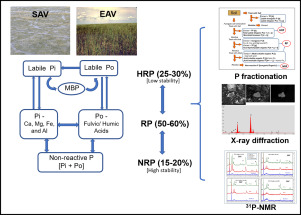Science of the Total Environment ( IF 8.2 ) Pub Date : 2020-04-04 , DOI: 10.1016/j.scitotenv.2020.138442 K R Reddy 1 , Lilit Vardanyan 1 , Jing Hu 1 , Odi Villapando 2 , Rupesh K Bhomia 1 , Taylor Smith 1 , W G Harris 1 , Sue Newman 2

|
Stormwater treatment areas (STAs) are an integral component of the Everglades restoration strategies to reduce phosphorus (P) loads from adjacent agricultural and urban areas. The overall objective of this study was to determine the forms and distribution of P in floc and soils along the flow-path of two parallel flow-ways (FWs) in STA-2 with emergent aquatic vegetation (EAV) and submerged aquatic vegetation (SAV), respectively, to assess their stability and potential for long term storage. In EAV high organic matter accretion supported low bulk density and high P concentrations in floc and soil, while high mineral matter accretion in SAV resulted in high bulk density and low P concentrations. Approximately 25–30% of the total P is identified as highly reactive P (HRP) pools, 50–60% in moderately reactive P (RP) forms, and 15–20% in the non-reactive P (NRP) pool. Within HRP and RP pools, a large proportion of P in the SAV areas was inorganic while organic P was more dominant in the EAV areas. Enrichment of total P (especially in HRP and RP pools) found in the upstream areas of both FWs resulted from the P loading into FWs over time, and the surplus P conditions can potentially support flux into the water column. In EAV FW, approximately 45% of the P retained was recovered in floc and RAS and remaining was possibly retained in the above and below ground biomass and incorporated into subsurface soils. In SAV FW, all of the P retained was recovered in floc and soils suggesting P retention in plants was not significant. For STAs to continue to function effectively and meet the desired outflow TP concentrations, management strategies should be aimed to promote P limiting conditions within the system to avoid release of P from floc and soils to water column and potential downstream transport.
中文翻译:

大沼泽地雨水处理区的土壤磷形态和储存:植被和养分负荷的影响。
雨水处理区 (STA) 是大沼泽地恢复战略的一个组成部分,旨在减少邻近农业和城市地区的磷 (P) 负荷。本研究的总体目标是确定 STA-2 中两个平行流道 (FW) 的絮体和土壤中 P 的形式和分布,其中包括挺水水生植被 (EAV) 和沉水水生植被 (SAV) ),分别评估其稳定性和长期储存的潜力。在 EAV 中,高有机质积聚支持絮体和土壤中的低容重和高磷浓度,而在 SAV 中,高矿物质积聚导致高容重和低磷浓度。总磷中约 25-30% 被确定为高反应性磷 (HRP) 库,50-60% 为中度反应性磷 (RP) 形式,15-20% 为非反应性磷 (NRP) 库。在 HRP 和 RP 池中,SAV 区域的大部分磷是无机磷,而 EAV 区域的有机磷占主导地位。两个 FW 上游区域的总 P 富集(特别是在 HRP 和 RP 池中)是由于随着时间的推移 P 加载到 FW 中造成的,并且过剩的 P 条件可能支持流入水体的通量。在 EAV FW 中,约 45% 的保留磷在絮体和 RAS 中回收,剩余的磷可能保留在地上和地下生物量中并融入地下土壤中。在 SAV FW 中,所有保留的磷均在絮体和土壤中回收,表明植物中磷的保留并不显着。 为了使 STA 继续有效地发挥作用并满足所需的流出 TP 浓度,管理策略应旨在促进系统内的磷限制条件,以避免磷从絮体和土壤释放到水柱和潜在的下游运输。











































 京公网安备 11010802027423号
京公网安备 11010802027423号